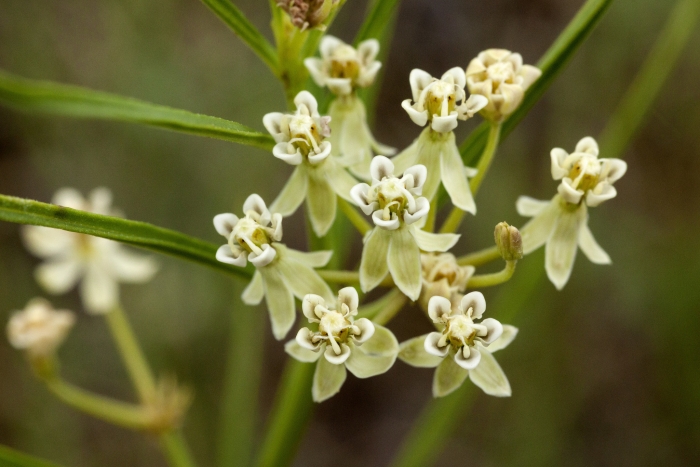Horsetail Milkweed
(Asclepias subverticillata)
Horsetail Milkweed (Asclepias subverticillata)
/
/

Cecelia Alexander
Public Domain
Image By:
Cecelia Alexander
Recorded By:
Copyright:
Public Domain
Copyright Notice:
Photo by: Cecelia Alexander | License Type: Public Domain | License URL: http://creativecommons.org/publicdomain/zero/1.0/ | Rights Holder: Cecelia Alexander | Publisher: iNaturalist | Date Created: 2017-08-20T13:50:51-07:00 |



















































Estimated Native Range
Summary
Asclepias subverticillata, commonly known as Horsetail Milkweed, is a deciduous perennial herb native to open grasslands, prairies, and desert scrub areas in the Southwestern United States and Mexico. It typically grows to a height of 2 feet (0.6 meters) and a width of 3 feet (0.9 meters). This species is characterized by its narrow, whorled leaves and clusters of small, intricate flowers that are white, green, and purple, blooming from late spring through fall. The flowers are quite showy and attract a variety of pollinators, including bees and butterflies, particularly the Monarch butterfly for which milkweeds are a crucial host plant.
Horsetail Milkweed is valued for its drought tolerance and ability to thrive in poor, well-drained soils, making it an excellent choice for xeriscaping and naturalized areas. It is also used in butterfly gardens and as part of pollinator-friendly landscaping. While it prefers full sun, it can tolerate light shade. Gardeners should be aware that all parts of the plant contain toxic compounds that can be harmful if ingested. Additionally, Horsetail Milkweed can spread readily by seeds, so it may require management to prevent unwanted colonization.CC BY-SA 4.0
Horsetail Milkweed is valued for its drought tolerance and ability to thrive in poor, well-drained soils, making it an excellent choice for xeriscaping and naturalized areas. It is also used in butterfly gardens and as part of pollinator-friendly landscaping. While it prefers full sun, it can tolerate light shade. Gardeners should be aware that all parts of the plant contain toxic compounds that can be harmful if ingested. Additionally, Horsetail Milkweed can spread readily by seeds, so it may require management to prevent unwanted colonization.CC BY-SA 4.0
Plant Description
- Plant Type: Herb
- Height: 1.5-4 feet
- Width: 1-3 feet
- Growth Rate: Moderate
- Flower Color: White, Green, Purple
- Flowering Season: Spring, Summer, Fall
- Leaf Retention: Deciduous
Growth Requirements
- Sun: Full Sun
- Water: Low, Medium
- Drainage: Fast
Common Uses
Bee Garden, Bird Garden, Butterfly Garden, Deer Resistant, Drought Tolerant, Fragrant, Hummingbird Garden, Low Maintenance
Natural Habitat
native to open grasslands, prairies, and desert scrub areas in the Southwestern United States and Mexico
Other Names
Common Names: Whorled Milkweed
Scientific Names: , Asclepias subverticillata, Asclepias verticillata var. subverticillata,
GBIF Accepted Name: Asclepias subverticillata (Gray) Vail